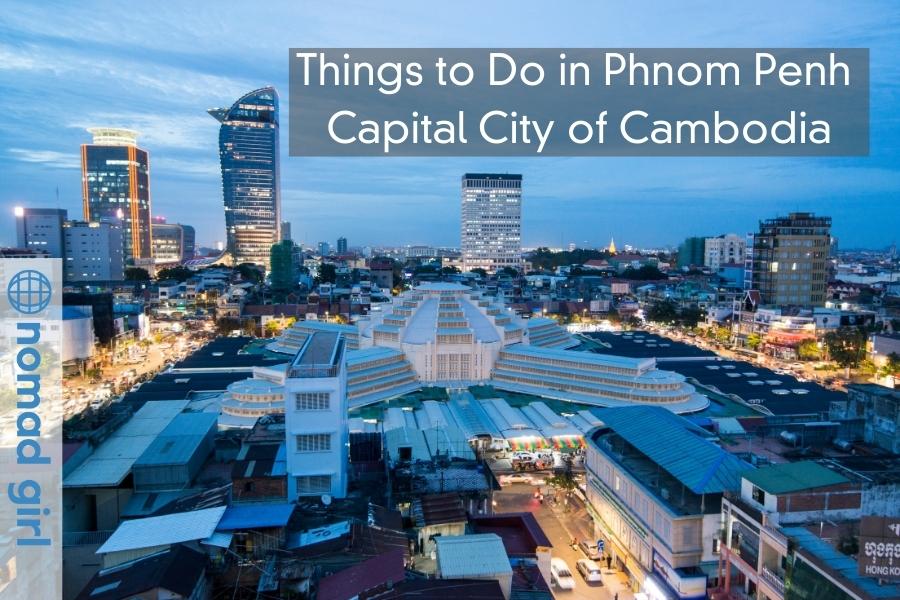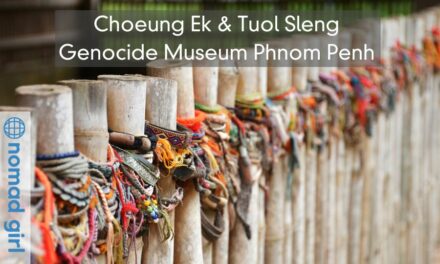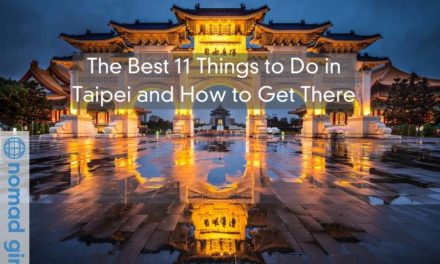Cambodia’s bustling capital Phnom Penh is the exotic, edgy, and enigmatic Asian city many people fancy from afar. In Phnom Penh, golden spires glitter under the sun, markets burst with colours, motorbikes scurry down narrow back alleys, and street food stalls spill into sidewalks. Phnom Penh is effortlessly but unconventionally beautiful.
The majestic Royal Palace and the many temples evoke a glorious past, while the solemn ‘killing fields’ mark a dreadful period in the country’s history. The riverside promenade, lined with eclectic eateries, chic cafés and boisterous bars, shows that Phnom Penh is all set to join the cosmopolitan capitals in South East Asia. Ready to explore this fascinating city? Here are the top 10 things to see in Phnom Penh.
1. The Royal Palace of Cambodia
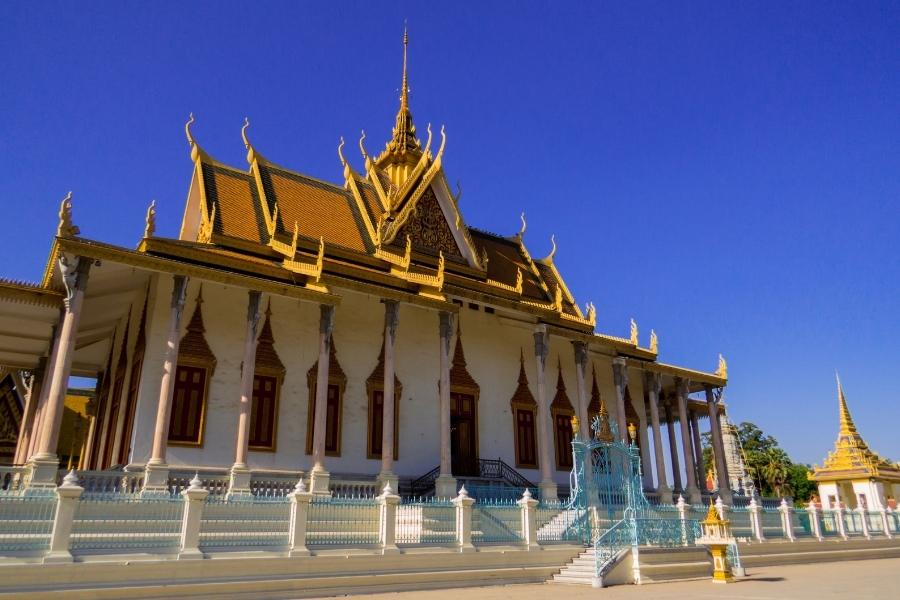
A spectacular structure by the riverfront, the Royal Palace once dominated the city skyline with its traditional Khmer roofs and intricate gilding. The palace is the official residence of the Cambodian king, so some parts of the compound are not open to the public.
Visitors can access the Throne Hall and the cluster of buildings surrounding it, including the open-air Moonlight Pavilion and the ornate Silver Pagoda, which houses the famous 17th-century Emerald Buddha. South of the Throne Hall lies the iron Napoleon III Pavilion, a gift by the French monarch to King Norodom.
Wear clothes that cover the shoulders, knees and elbows when visiting the Royal Palace. On Sundays, it fills with Khmers from the countryside who visit to pay their respects. If you want to escape the crowd, drop by on other days. However, seeing the palace with locals is a unique experience.
2. National Museum of Cambodia
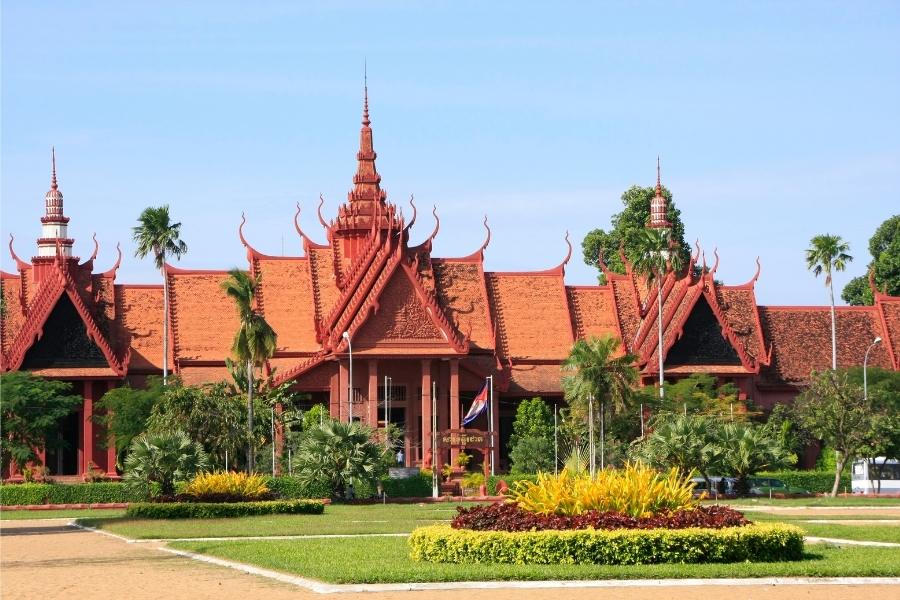
A short distance north of the Royal Palace is the National Museum of Cambodia, housed in a traditional terracotta building with a gorgeous courtyard garden at the centre. Completed in 1920, the museum contains more than 14,000 art pieces arranged according to different eras. Some exhibits date back to prehistoric Cambodia, while others are from the golden age of Angkor. One of the main attractions is the impressive statue of King Jayavarman VII (1181 to 1219) in a meditation pose.
There are also imposing sculptures of the Hindu gods Vishnu and Shiva from the 5th and 8th centuries, ancient tablets with Sanskrit and Old Khmer inscriptions, potteries from a prehistoric burial site, and a more recent wooden royal boat.
Visitors may not take photos of the artefacts and collections, only of the courtyard. The museum offers guided tours in English, French, Spanish and Japanese and is open daily from 8 am to 5 pm.
3. Tuol Sleng Genocide Museum

The most notorious and gruesome prison in Cambodia, Tuol Sleng Genocide Museum, is depressing and not for the faint-hearted. When the Khmer Rouge took over Phnom Penh in 1975, they turned Tuol Svay Pray High School into an interrogation and torture centre known as S-21. The prison held between 14,000 to 17,000 people in the course of four years. Only seven prisoners survived upon the city’s liberation.
The prison is now a museum. But most parts of the building were left in the state they were found, with torture rooms still in place, scratch marks on the wall, and blood stains on the floor. The most prominent displays in the museum are the 6,000 haunting portraits of the prisoners, which included a significant number of children. To better understand the exhibits and learn about the stories of the survivors, consider listening to the audio guide as you explore the compound.
4. Wat Ounalom Monastery
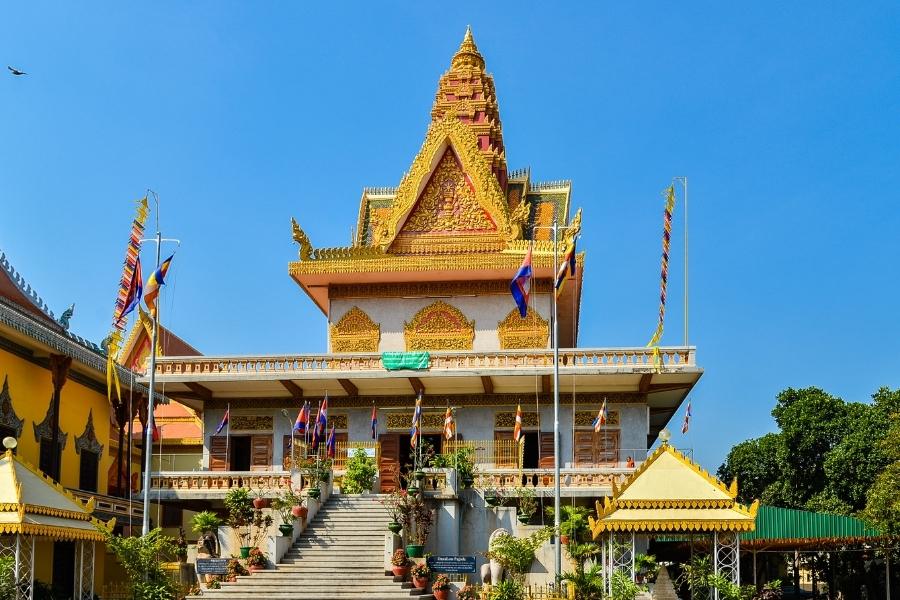
Built between 1422 and 1443, Wat Ounalom is the seat of Cambodian Buddhism. It once housed over 500 monks and the Buddhist Institute library with its collection of more than 30,000 titles. There are 44 structures in the compound, including a shrine containing the eyebrow hair of Buddha.
The Khmer Rouge regime damaged many parts of the wat. On the third floor of the main building, you’ll find a small marble Buddha enclosed in a glass case. The statue was broken into pieces by the Khmer Rouge and later repaired. Entrance to the wat is free.
5. Choeung Ek Genocidal Center
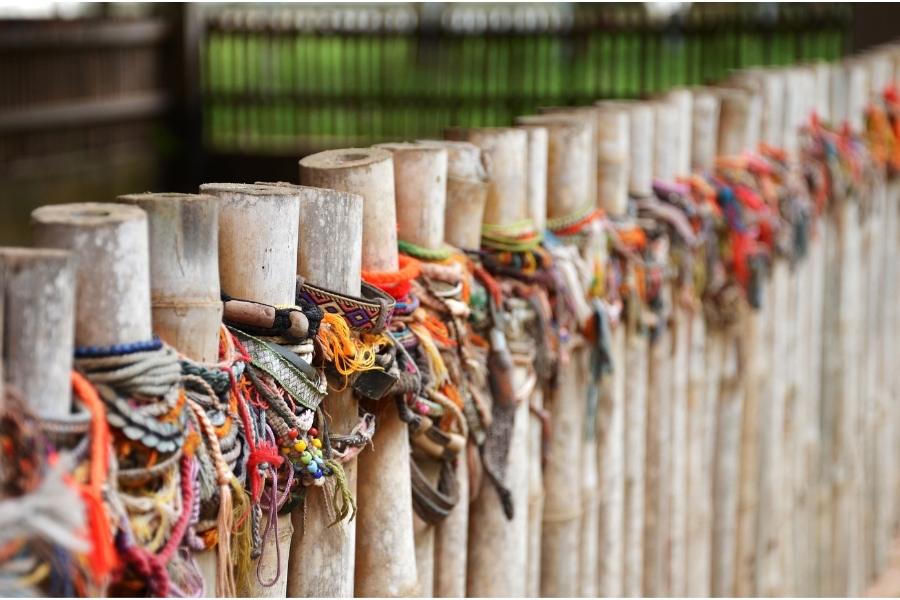
About 11 miles south of the city centre, in the village of Choeung Ek, lies one of the Khmer Rouge’s many killing fields, where political prisoners were executed and buried between 1975 to 1979. Mass graves with 8985 bodies were discovered in a fruit orchard in Choeung Ek in 1980. Forty-three of the 129 open graves remain untouched, and bits of human bones and clothing sticks out from these exposed pits.
After a heavy rain, more bones appear on the ground. In 1988, a memorial stupa containing more than 8000 skulls was erected in Choeung Ek’s killing field. A memorial ceremony is held on the site every May 20th.
6. Cambodian Living Arts Theatre Show
Watching classical Khmer dances by the Cambodian Living Arts is something you should experience on your trip to Phnom Pehn. The Cambodian Living Arts is a non-profit organization that aims to revive and preserve traditional Khmer performing arts almost lost under the Khmer Rouge regime by gathering surviving experts to train the younger generation.
A troupe of singers, dancers, and musicians in beautiful Khmer costumes will showcase dances of Cambodia’s ethnic minorities, enacting epic poems and legends using complex moves. The shows are on Mondays, Wednesdays and weekends at 7 pm. You can book a tour culminating in a dinner with performers presenting traditional dances and music on stage.
7. The Central Market of Phnom Penh

This massive, golden-domed structure, locally known as Phsar Thmey, is one of the most iconic landmarks in Phnom Penh. Constructed in 1937 in Art Deco style by French architects, the Central Market was once the largest indoor shop in Asia. Thousands of stalls sell almost anything, from jewellery to clothing to handicrafts to flowers and knock-offs of popular brands. Even if you don’t plan on buying anything, you will enjoy wandering around and exploring the many colourful stalls.
It’s also a fantastic opportunity to immerse yourself in the hustle and bustle of local life. If you get hungry, there’s a row of food stands that sell traditional Khmer cuisine and exotic street food, such as fried bugs and spiders. Bring your camera to capture the fascinating sights and vibrant scenery.
8. Sisowath Quay
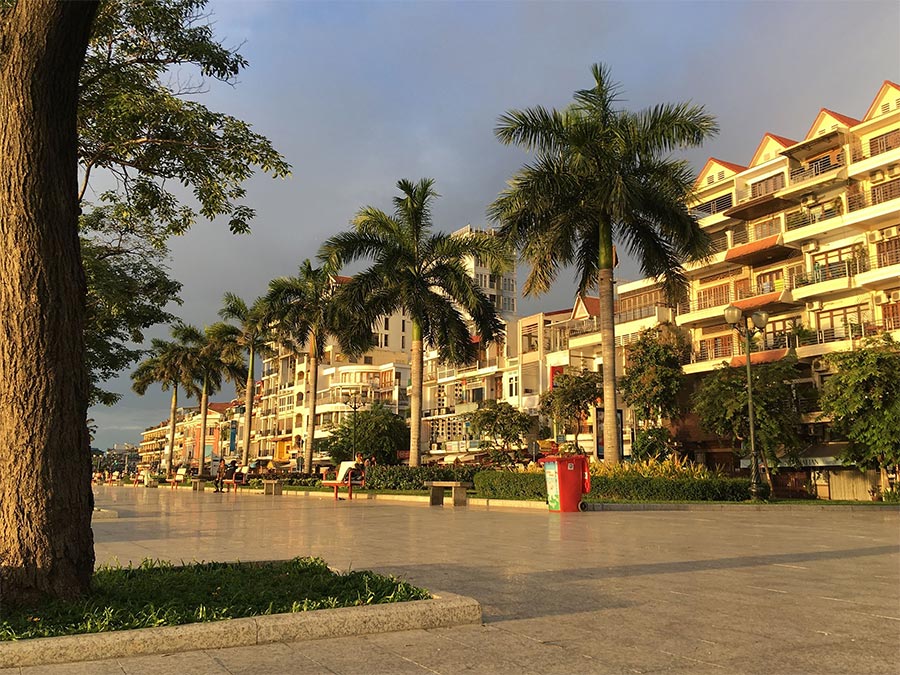
The 3-km Sisowath Quay lies at the intersection of the Mekong and Tonle Sap rivers. Lined by rows of bars, boutiques, cafés, and restaurants, this palm-fringed boulevard is one of the busiest parts of the city. Despite the buzz, its atmosphere remains laid back and relaxing. If you visit late in the afternoon, you can sit by the river and watch the sun setting over the city. As dusk descends, the boardwalk fills with joggers, dog walkers, and locals enjoying the cool night air. Makeshift street food stalls pop up along the promenade as well. Be sure to try the grilled skewers and coconut ice cream.
9. Phnom Tamao Zoological Park and Wildlife Rescue Center
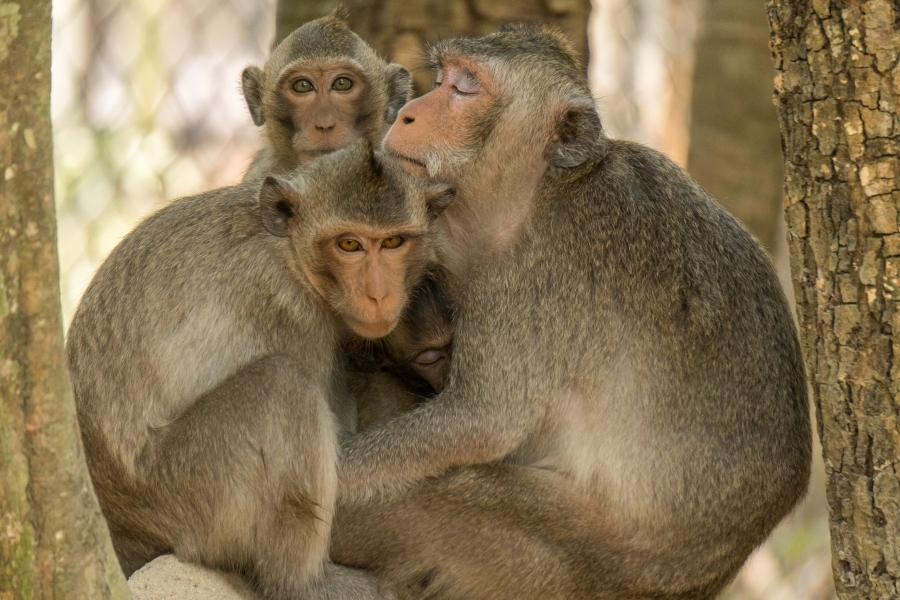
The Phnom Tamao Wildlife Center is technically not in Phnom Penh, but it is worth the 2.5-hour drive from the capital. This wildlife park sits on a 6,000-acre protected forest and is the country’s largest sanctuary and conservation centre. It is home to over 1,200 animals, including bears, crocodiles, elephants, gibbons, leopards, and tigers. Many of these were rescues from trafficking and illegal wildlife trade.
The best way to get to the Phnom Tamao Wildlife Center is through the Wildlife Alliance. The tour is a fundraising activity, and all the profits are for the rescue, rehabilitation, and release of animals into the wildlife.
10. Independence Monument
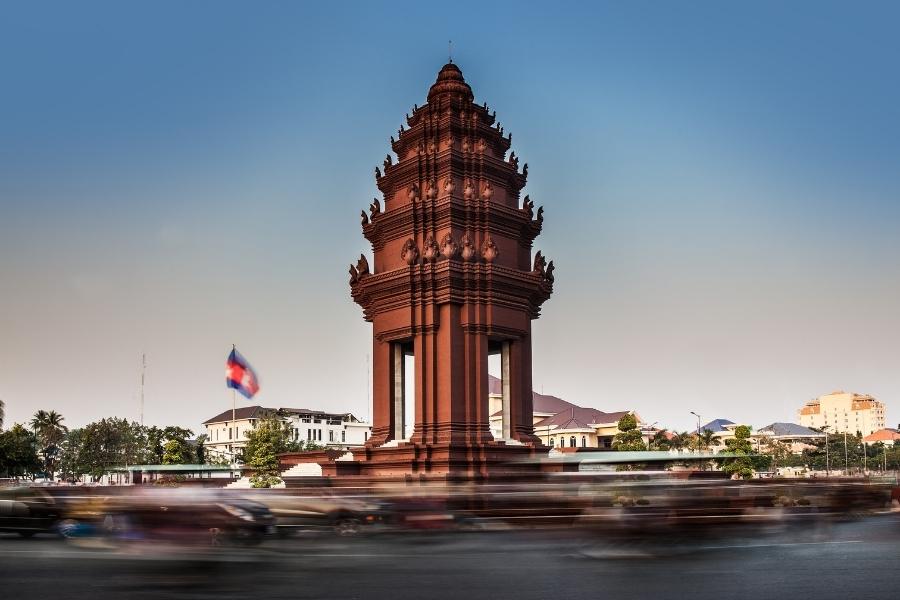
A historic landmark in the heart of the city centre, the monument represents Cambodia’s liberation from the French, who colonized the country from 1863 to 1953. It was built in 1958 and modelled after the central tower of Angkor Wat. Cambodians commemorate national holidays, such as Constitution Day and Independence Day, by laying wreaths at the monument. The Independence Monument looks imposing in daylight, but it appears more majestic at night when it is lit blue, red and white.
Phnom Pehn – Digital Nomad City
Cambodia with its cheap cost of living, great food and plenty of interesting sights. Check out our list of digital nomad places in Cambodia & Laos.


